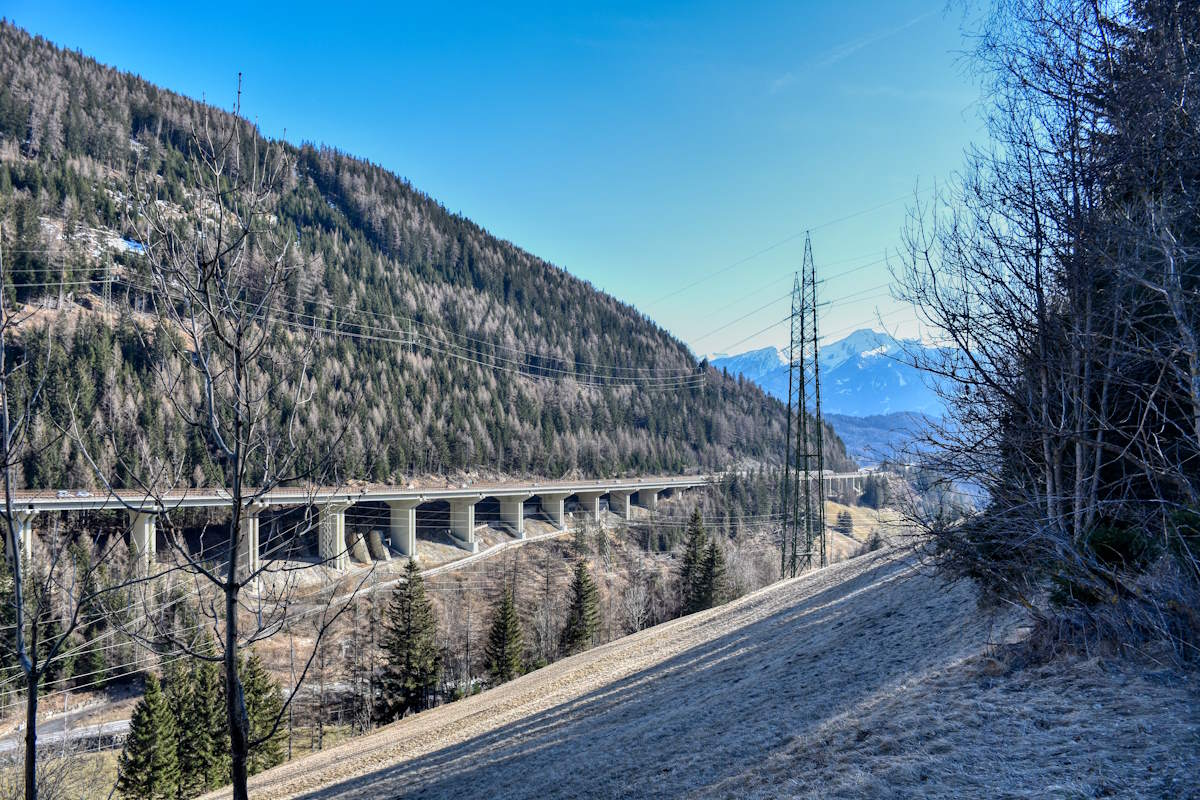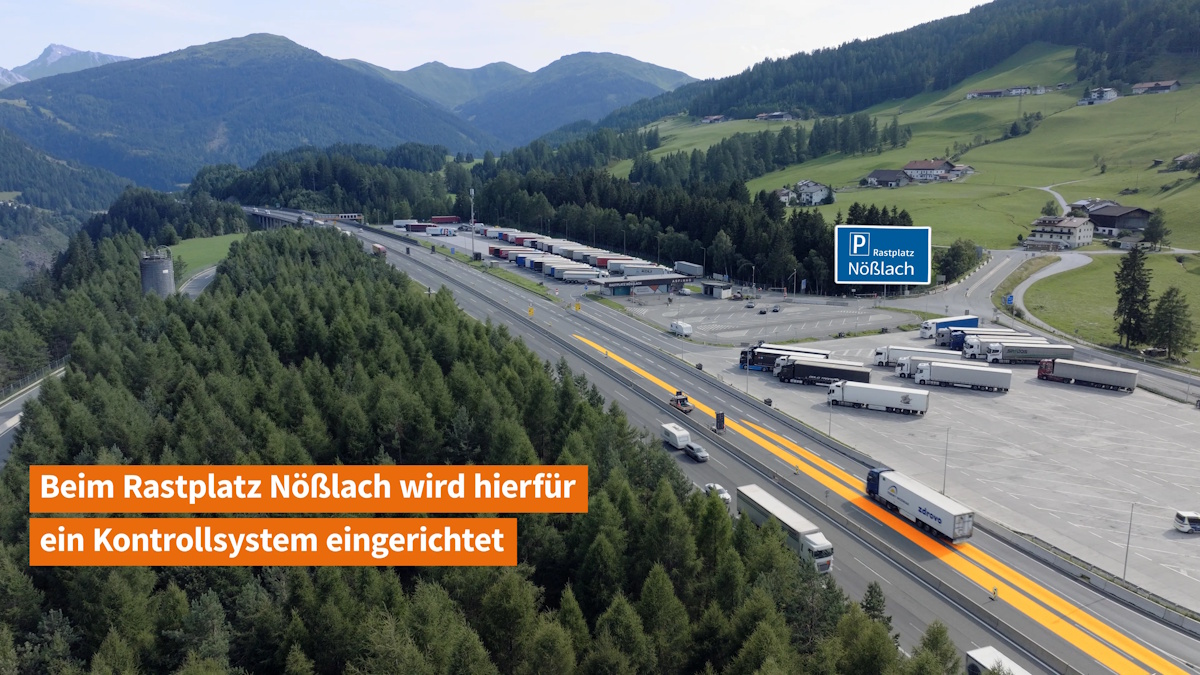by Florian König, maut1.de - 23 December 2024
After more than 55 years, the Lueg Bridge on the A13 Brenner motorway has reached the end of its useful life. After tough disputes about the necessary construction measures, the bridge will only be open to single-lane traffic from 1 January 2025. The new construction of the Lueg Bridge, which will have 2 supporting structures in future, is scheduled to begin in spring 2025.
Single-lane traffic routing on the Lueg Bridge
In order to provide structural safety relief on the Lueg Bridge for the next few years during the construction work, traffic will only be routed in one lane over the section of road from 1 January 2025. For periods with high traffic volumes, such as during holiday periods or the summer months, a temporary two-lane traffic routing on the Lueg Bridge will be possible thanks to a special traffic management system.
In the run-up to the construction work, new road markings were installed and a control system for heavy vehicles was installed at the Nößlach rest area, among other things. In future, all vehicles over 3.5 tonnes will drive on the inside of the Luegbrücke bridge directly above the support pillars and lighter car traffic will also drive in the outside lane for a limited period of time. The fact that the existing Lueg Bridge can continue to operate safely was confirmed in a scientific test in 2024.

When will the Luegbrücke bridge be dual carriageway and how will traffic be regulated?
Together with the province of Tyrol and the ministry, ASFiNAG has developed a driving calendar with driving bans for vehicles over 7.5 t and the planned traffic routing to enable all travellers (transport, tourism or private) to plan all journeys on the A13 Brenner motorway in the best possible way.
In 2025, two-lane traffic routing will be set up flexibly on the Lueg Bridge on around 170 days - either northbound or southbound, depending on demand. In addition, new measures such as a traffic control system, additional lorry driving bans and section control will be implemented. Comprehensive information on the measures will also be provided in other countries across Europe through a campaign.
Heavy goods traffic over 3.5 tonnes will be diverted from the normally used right-hand lane to the left-hand lane on the way to the Luegbrücke bridge with the help of traffic signs. Monitoring cameras and a weight check at the Nößlach rest area ensure that the largest traffic load is centred over the supporting pillars on the bridge, thereby relieving the load on the bridge.
The three construction phases on the Lueg Bridge at a glance
The planned renovation work around the Lueg Bridge is divided into three construction phases. Firstly, a new supporting structure will be erected underneath the bridge within 2-3 years, after completion, traffic will be diverted onto this new supporting structure and the old supporting structure (the 55-year-old Lueg Bridge) will be completely demolished. A completely new structure will then be built in place of the old bridge so that traffic can be routed over two separate structures in future.

The new Lueg Bridge will be designed as a modern slope bridge that meets current and future traffic requirements. The planned widening of the carriageway by over 8 metres to a total of 30.5 metres is intended to improve traffic flow and increase safety.
Further details about the construction measures
New markings on the A 13 Brenner motorway
Parts of the A13 Brenner motorway are being resurfaced to improve traffic safety and accessibility for emergency services. Between Matrei and the Brenner state border, the A13 motorway will be re-marked from three lanes to two lanes.
Regulation of lorry driving bans
In order to avoid congestion on busy days, further lorry driving bans are necessary, which can be imposed by the responsible ministry.
Expansion of the "Rolling Road" service
On certain days, the "Rolling Highway" service is to be extended to provide more capacity for heavy goods vehicles.

New installation of barrier systems
In order to improve traffic routing and close off slip roads as required, seven barrier systems are being installed on lower-ranking roads to protect the neighbouring communities along the A13 Brenner motorway from traffic jams and traffic on the way out.
Additional traffic cameras
ASFINAG is expanding the camera infrastructure along the A13 Brenner motorway in order to better assess the traffic situation and take measures if necessary. This also includes the B 182 Brenner federal motorway to ensure that the traffic situation can be monitored in real time.
Expansion of display systems
Twelve million euros will be invested in the expansion of the display systems on the entire approach route and at the Brenner Pass and, for example, the renovation of seven portals of the traffic control system will be brought forward. In addition, 17 further traffic control systems will be installed for traffic information, dynamic traffic diversion options and the activation of driving bans.
Construction of the Luegbrücke control system
In the area of the Nößlach rest area and at the Brenner-Nord control point, a new control infrastructure with integrated scales will be installed on the route. This will ensure compliance with the designated lanes - heavy traffic over 3.5 tonnes on the inside, light traffic under 3.5 tonnes on both lanes.
If the wrong lane is used, a display and diversion system ensures that these heavy vehicles cannot pass the bridge and are diverted from the A13 to the correct lane. At the Nößlach car park, these vehicles can be checked again and then re-integrated into the correct lane via a local guidance system.

Europe-wide information campaign
A transnational campaign in Europe, focussing on Austria, Germany, Italy and the Netherlands, will inform all road users in advance about the measures surrounding the construction of the new Lueg Bridge.
Package of measures for the Wipptal & Brenner tributaries
Measure 1: Driving bans
In order to keep through traffic on the motorway and relieve the side roads, driving bans are imposed for the Wipptal valley and the greater Innsbruck area. These will initially apply from 1 January to 28 February, in each case from 7 am to 7 pm.
Direction south:
- L 9 Middle mountain road in the municipality of Ampass,
- L 38 Ellbögener road in the municipalities of Ampass, Tulfes and Patsch,
- Municipal road Nösslach in the municipality of Gries am Brenner,
- L 11 Völser road in the municipality of Völs and Zirl,
- B 171b Tiroler road and the municipal roads Grießenweg and Aflingerstraße in the municipality of Völs,
- L 13 Sellraintal road in the municipality of Sellrain and the municipality of Kematen in Tirol and
- L 394 Axamer road in the municipality of Kematen in Tirol.
Direction north:
- Municipal road Nösslach in the municipality of Gries am Brenner,
- L 38 Ellbögener road in the municipalities of Matrei am Brenner and Patsch
- L 226 Natterer road and L 227 Mutterer Straße in the municipalities of Natters and Mutters.
Measure 2: Metering traffic lights on the B 182
In order to ensure traffic safety on the B 182 Brennerstraße and keep traffic flowing smoothly, five additional metering traffic lights will be put into operation from 1 January 2025.
The metering lights in the southbound direction are located:
- in Mutters (in front of the entrance to the Mutters business park)
- in Schönberg im Stubaital (after the exit from the Stubai Valley)
- in Matrei am Brenner (before the Mühlbachl district, travelling south)
- in Steinach am Brenner (before entering the town, travelling south)
- in Gries am Brenner (before entering the town, travelling south)
The metering lights in the northbound direction are located:
- after the Brenner Nord junction
- in Gries am Brenner (before the entrance to the village)

Measure 3: Public transport
Public transport is also an important component in mitigating capacity restrictions on the A13 Brenner motorway. To this end, rail services in the Wipptal valley have been expanded: There are 33 transfer-free connections per day and direction between Innsbruck and the Brenner at half-hourly intervals.
In addition, intensive work has been done to expand the bus service in the Wipptal and its side valleys, so that the first bus can be used as early as 5:44 am.
Measure 4: no construction sites
There should be no additional construction measures along the B 182 Brennerstraße in 2025 in order to reduce additional congestion potential. Since 2024, urgently needed renovation work has been carried out on the Hallensteinbrücke, Stafflacher Sillbrücke and Schmirnbachbrücke bridges, which is expected to be completed by April 2025.
Recommendations for travellers on the A13 Brenner motorway
- Timely information: Use the latest traffic information and plan your journey accordingly.
- Alternative route: Consider using alternative routes to the Brenner Pass and the Lueg Bridge to avoid traffic jams.
- Public transport: In some cases, taking the train or bus can be a sensible alternative.
Conclusion
The new construction of the Lueg Bridge is a necessary major project to ensure long-term traffic safety and infrastructure on the A13 Brenner motorway. Despite the impending disruptions during the construction period, the new bridge will make an important contribution to improving traffic flow and safety on this important transit route in the future.


.webp?ts=1751463967)